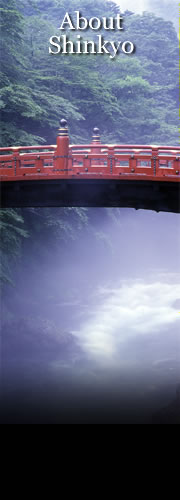1. Shinkyo -the sacred bridge-
Vermilion lacquered sacred bridge; the beautiful Shinkyo is worth enough to
decorate the entrance of sanctuary Nikko. The Shinkyo is also called
Yamasugeno-jabashi, which means snake bridge of sedge. This bridge belongs to
Futarasan Shrine and is designated as an important cultural property. In
addition, Shinkyo was registered as the World Heritage in December 1999.
Shinkyo is 28 meters long, 7.4 meters wide, and located 10.6 meters above the
river. Ten main pillars are built on the rail, and top of each pillar is
decorated. Opposite side of the bridge girder is black lacquered, while whole
other parts are vermilion lacquered.
Establishment of Shinkyo is full of mystery, but is respected as a sacred
bridge. Shinkyo was rebuilt in 1636 and became today’s appearance. After
that, Shinkyo had been opened to only Generals and messengers from the imperial
court. Instead, temporary bridge was opened to ordinary people.
Shinkyo opened its door to the general public in 1973 for the purpose of
preparing upcoming event. The event was held in 1982 for the celebration of
the1200th anniversary that Mt. Nantai was enshrined in 782. Shinkyo has had a
big reforming period since 1997. Shinkyo is the oldest bridge in Japan in terms
of drawbridge style built over the gorge. Also, Shinkyo is known as one of the
finest three bridges (Kintaikyo Bridge in Yamaguchi prefecture, Saruhashi Bridge
in Yamanashi pref.) in Japan.
|











